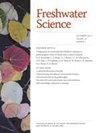Winners and losers over a ½ century of change in crayfish assemblages of Wyoming, USA
IF 1.6
4区 环境科学与生态学
Q3 ECOLOGY
引用次数: 0
Abstract
Crayfish have experienced extensive assemblage reorganization as a result of global change, with some species becoming globally invasive and others becoming rare or extinct. We combined historical and contemporary sampling data to determine temporal trends of crayfish assemblages of Wyoming, USA, identifying winners and losers over a ½ century of change (1969–2020). We first documented range expansions of several species, including the Virile Crayfish Faxonius virilis (Hagen, 1870), Ringed Crayfish Faxonius neglectus (Faxon, 1885), and Rusty Crayfish Faxonius rusticus (Girard, 1852) as well as range contractions of the Calico Crayfish Faxonius immunis (Hagen, 1870) and Pilose Crayfish Pacifastacus gambelii (Girard, 1852). We then used multispecies occupancy models to investigate potential mechanisms behind the replacement of F. immunis by F. virilis as the most commonly detected crayfish species in Wyoming over time. We hypothesized that F. virilis is more likely to competitively displace F. immunis from more permanent waterbodies, whereas F. immunis is more likely to persist in more ephemeral habitats because of its superior burrowing ability and tolerance of low dissolved oxygen concentrations. Our occupancy models supported this prediction, with F. immunis occupancy declining at more permanent sites in the presence of F. virilis, but F. immunis occupancy was unaffected by F. virilis in less permanent sites. We also found positive associations of F. virilis occupancy and detection probability with water temperature, suggesting that warmer streams may be more vulnerable to new invasions or spread by this species in nonnative regions of western North America. Our results highlight the value of regular, statewide crayfish surveys through documenting substantial changes in Wyoming’s crayfish assemblage structure that may be driven by habitat-mediated competitive interactions.半个世纪以来美国怀俄明州小龙虾种群变化的赢家和输家
由于全球变化,小龙虾经历了广泛的组合重组,一些物种成为全球入侵物种,另一些物种变得稀有或灭绝。我们结合历史和当代采样数据来确定美国怀俄明州小龙虾组合的时间趋势,确定在半个世纪的变化中(1969-2020)的赢家和输家。我们首先记录了一些物种的范围扩大,包括雄性小龙虾Faxonius virilis (Hagen, 1870),环状小龙虾Faxonius忽略(Faxon, 1885)和Rusty小龙虾Faxonius rusticus (Girard, 1852),以及斑点小龙虾Faxonius免疫(Hagen, 1870)和毛小龙虾Pacifastacus gambelii (Girard, 1852)的范围缩小。然后,我们使用多物种占用模型来研究随着时间的推移,绒毛F.取代免疫F.作为怀俄明州最常见的小龙虾物种背后的潜在机制。我们假设,绒毛F.更有可能从更永久的水体中竞争性地取代免疫F.,而免疫F.更有可能在更短暂的栖息地中生存,因为它具有优越的挖洞能力和对低溶解氧浓度的耐受性。我们的占位模型支持这一预测,免疫F.在更永久的地点,在有F. virilis存在的情况下,免疫F.占位下降,但在不太永久的地点,免疫F.占位不受F. virilis的影响。我们还发现,在北美西部的非原生地区,较温暖的溪流可能更容易受到该物种的新入侵或传播。我们的研究结果强调了定期的全州小龙虾调查的价值,通过记录怀俄明州小龙虾组合结构的实质性变化,这些变化可能是由栖息地介导的竞争相互作用驱动的。
本文章由计算机程序翻译,如有差异,请以英文原文为准。
求助全文
约1分钟内获得全文
求助全文
来源期刊

Freshwater Science
ECOLOGY-MARINE & FRESHWATER BIOLOGY
CiteScore
4.10
自引率
0.00%
发文量
49
审稿时长
6-12 weeks
期刊介绍:
Freshwater Science (FWS) publishes articles that advance understanding and environmental stewardship of all types of inland aquatic ecosystems (lakes, rivers, streams, reservoirs, subterranean, and estuaries) and ecosystems at the interface between aquatic and terrestrial habitats (wetlands, riparian areas, and floodplains). The journal regularly features papers on a wide range of topics, including physical, chemical, and biological properties of lentic and lotic habitats; ecosystem processes; structure and dynamics of populations, communities, and ecosystems; ecology, systematics, and genetics of freshwater organisms, from bacteria to vertebrates; linkages between freshwater and other ecosystems and between freshwater ecology and other aquatic sciences; bioassessment, conservation, and restoration; environmental management; and new or novel methods for basic or applied research.
 求助内容:
求助内容: 应助结果提醒方式:
应助结果提醒方式:


